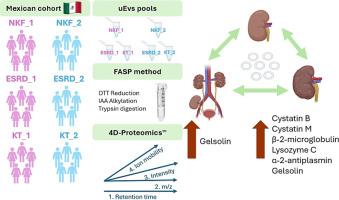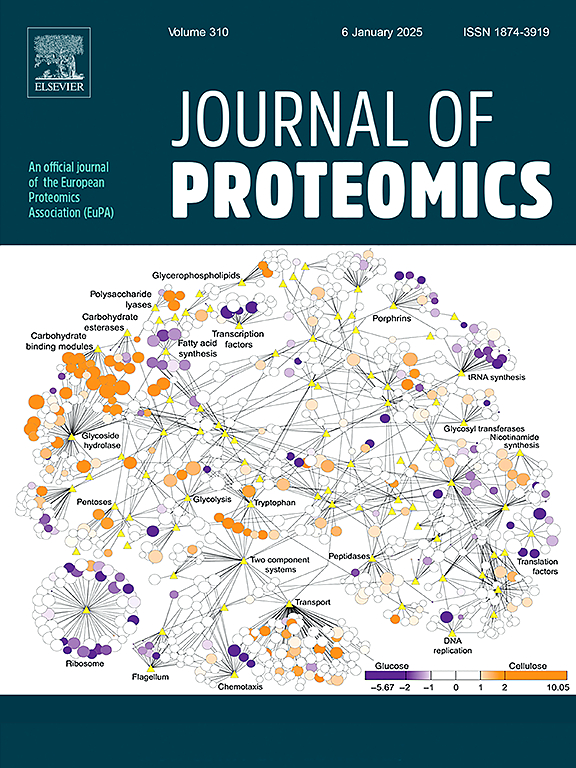终末期肾病和移植后患者尿细胞外囊泡中潜在的肾脏生物标志物
IF 2.8
2区 生物学
Q2 BIOCHEMICAL RESEARCH METHODS
引用次数: 0
摘要
慢性肾脏疾病是一种以肾小球滤过率(GFR)降低为特征的多因素疾病。疾病的最后阶段需要肾脏替代治疗或肾移植。蛋白质组学作为一种疾病,在早期阶段无法治疗,而且可用的生物标志物很少,因此它是一种寻找新的更有效的生物标志物的极好工具。尿细胞外囊泡是肾脏改变的重要信息来源,它们的收集是无创的。在这项探索性研究中,我们收集了来自哈利斯科州瓜达拉哈拉国家西方医学中心患者的尿液样本,并通过超离心分离出尿细胞外囊泡(uEVs)。我们的目的是比较墨西哥肾功能正常、终末期肾病或肾移植患者uEVs的蛋白质组学特征。高分辨率质谱分析揭示了终末期肾脏疾病在能量代谢、细胞骨架组织和细胞运动方面的变化。移植患者的蛋白质组学改变指向纤维化过程的保存。重要的蛋白质,如胱他汀类,可以作为肾移植监测的候选蛋白,而Gelsolin,一种在评估足细胞损伤中起重要作用的蛋白质,作为慢性肾脏疾病的可能标记物而突出。数据可通过ProteomeXchange获得,标识符为PXD065380。慢性肾脏疾病是一种日益严重的公共卫生负担,每年都在增加,并且是糖尿病和高血压等主要慢性疾病的首选。尽管墨西哥是慢性肾脏疾病发病率最高的国家之一,但尚未开展涉及墨西哥患者的蛋白质组学研究。uEVs是研究疾病和发现生物标志物特别感兴趣的特征。我们描述了墨西哥患者的uEVs蛋白质组学特征,为慢性肾脏疾病和肾移植疾病的发病机制提供了新的见解。我们确定了移植监测的有希望的生物标志物候选物,其中一个作为ESRD进展的早期指标。uev可以作为肾脏疾病调查的非侵入性平台,潜在地为患者监测提供非侵入性生物标志物,并为未来肾脏病理生理学研究提供机制见解。本文章由计算机程序翻译,如有差异,请以英文原文为准。

Potential kidney biomarkers in urinary extracellular vesicles from end stage renal disease and post-transplant patients
Chronic kidney disease is a multifactorial entity characterized by decreased glomerular filtration rate (GFR). The last stage of the disease requires renal replacement therapy or kidney transplantation. As a disease with no treatment at earlier stages, and few biomarkers available, proteomics represent an excellent tool searching for new more efficient biomarkers. Urinary extracellular vesicles are an important source of information for kidney alterations, and their collection is not invasive. In this exploratory study, we worked on urine samples collected from patients at Centro Medico Nacional de Occidente in Guadalajara, Jalisco, and isolated urinary extracellular vesicles (uEVs) by ultracentrifugation. Our objective was to compare the Proteomic Profile of uEVs between Mexican patients with normal kidney function, end-stage renal disease, or kidney transplantation. High resolution mass spectrometry analysis reveals alterations in end-stage renal disease regarding the energy metabolism, cytoskeleton organization and cell motility. Proteomic alterations in transplant patients point towards the conservation of fibrotic process. Important proteins such as cystatins can be proposed as candidates for kidney transplant monitoring, while Gelsolin, a protein with an important role in assessing podocyte damage, stands out as a probable marker of chronic kidney disease. Data are available via ProteomeXchange with identifier PXD065380.
Significance
Chronic Kidney disease is a growing public health burden, increasing each year, and favored by major chronic diseases such as diabetes and hypertension. Although Mexico is one of the countries with the highest incidence of chronic kidney disease, proteomics studies involving Mexican patients had not yet been conducted. uEVs are features of particular interest to study the disease and discover biomarkers. We characterized the uEVs proteomic profile in Mexican patients, providing new insights into the pathogenesis of chronic kidney disease and kidney transplantation disorders. We identified promising biomarker candidates for transplant monitoring, and one as an early indicator of ESRD progression. uEVs may serve as a non-invasive platform for renal disease investigation, potentially offering non-invasive biomarkers for patient monitoring as well as mechanistic insights for future research into kidney pathophysiology.
求助全文
通过发布文献求助,成功后即可免费获取论文全文。
去求助
来源期刊

Journal of proteomics
生物-生化研究方法
CiteScore
7.10
自引率
3.00%
发文量
227
审稿时长
73 days
期刊介绍:
Journal of Proteomics is aimed at protein scientists and analytical chemists in the field of proteomics, biomarker discovery, protein analytics, plant proteomics, microbial and animal proteomics, human studies, tissue imaging by mass spectrometry, non-conventional and non-model organism proteomics, and protein bioinformatics. The journal welcomes papers in new and upcoming areas such as metabolomics, genomics, systems biology, toxicogenomics, pharmacoproteomics.
Journal of Proteomics unifies both fundamental scientists and clinicians, and includes translational research. Suggestions for reviews, webinars and thematic issues are welcome.
 求助内容:
求助内容: 应助结果提醒方式:
应助结果提醒方式:


